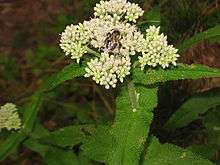Eupatorium perfoliatum
| Eupatorium perfoliatum | |
|---|---|
| Scientific classification | |
| Kingdom: | Plantae |
| Clade: | Angiosperms |
| Clade: | Eudicots |
| Clade: | Asterids |
| Order: | Asterales |
| Family: | Asteraceae |
| Genus: | Eupatorium |
| Species: | E. perfoliatum |
| Binomial name | |
| Eupatorium perfoliatum | |
 | |
| Synonyms[2] | |
|
Synonymy
| |
Eupatorium perfoliatum or (common) boneset is a common North American perennial plant in the aster family. It is native to the Eastern United States and Canada, widespread from Nova Scotia to Florida, west as far as Texas, Nebraska, the Dakotas, and Manitoba.[3][4] It is also called "agueweed", "feverwort" or "sweating-plant". It was introduced to American colonists by natives who used the plant for breaking fevers by means of heavy sweating. It is nearly always found in low, wet areas and is often found near Phalaris arundinacea (reed canary grass).
Description

Eupatorium perfoliatum grows up to 100 cm (39 inches) tall, with leaves that clasp the stems. The plant produces dense clusters of tiny white flower heads held above the foliage.
Eupatorium perfoliatum can form hybrids with other species of the genus Eupatorium, for example Eupatorium serotinum.[3]
Medicinal uses
Eupatorium perfoliatum was used in the traditional medicine of Native Americans and extracts are now used in herbal medicine for fever and colds.[5] The effects of Eupatorium perfoliatum have not been confirmed by clinical study.[5] However, animal studies and in vitro experiments with plant extracts indicate possible anti-inflammatory effects and activity against Plasmodium falciparum, the parasite that causes malaria.[5]
Frederick Klenner, MD, recounted his mother’s use of Eupatorium perfoliatum during the flu epidemic of 1918, which ravaged the U.S. and many other countries. As hundreds of people died of the flu in Klenner’s hometown of Johnstown, Pennsylvania, 10-year-old Fred and his 12-year-old sister Agnes fell ill with high temperatures. Their mother Mary, steeped in herbal remedies, gave both children large doses of bitter tea made from Eupatorium perfoliatum leaves. Both recovered.[6]
“Most farmsteads had a bundle of dried Boneset [Eupatorium perfoliatum] in the attic or woodshed,” recalled Klenner, “from which a most bitter tea would be meted out to the unfortunate victim of a cold or fever. …We qualified many times for this particular drink. …Several years ago my curiosity led me to assay this ‘herbal medicine’ and—to my surprise and delight—I found that we had been taking from ten to thirty grams of natural vitamin C at one time. Even then it was given by body weight. Children one cupful; adults two to three cupfuls.”[7]
The leaves growing together around the stem lead to a past superstition that wrapping the leaves in bandages around splints would help broken bones set.[8] Boneset also had other medical uses,[8] and was a very common remedy in the United States in the 19th century.[9] [10]
Butterflies
Eupatorium perfoliatum is a specific butterfly food and habitat plant. It provides nectar for butterflies in the adult life cycle stage, particularly the White M hairstreak and the Bronze Copper butterfly.
Reference Notes
- ↑ "Eupatorium perfoliatum". NatureServe Explorer. NatureServe. Retrieved 2010-09-12.
- ↑ "Eupatorium perfoliatum L.". The Global Compositae Checklist (GCC) – via The Plant List.
- 1 2 Siripun, Kunsiri Chaw; Schilling, Edward E. (2006). "Eupatorium perfoliatum". In Flora of North America Editorial Committee. Flora of North America North of Mexico (FNA). 21. New York and Oxford – via eFloras.org, Missouri Botanical Garden, St. Louis, MO & Harvard University Herbaria, Cambridge, MA.
- ↑ "Eupatorium perfoliatum". County-level distribution map from the North American Plant Atlas (NAPA). Biota of North America Program (BONAP). 2014.
- 1 2 3 Hensel, Andreas; Maas, Mareike; Sendker, Jandirk; Lechtenberg, Matthias; Petereit, Frank; Deters, Alexandra; Schmidt, Thomas & Stark, Timo (2011). "Eupatorium perfoliatum L.: Phytochemistry, traditional use and current applications". Journal of Ethnopharmacology. 138 (3): 641–651. doi:10.1016/j.jep.2011.10.002. PMID 22004891.
- ↑ Jerry Bledsoe. Bitter Blood: A True Story of Southern Family Pride, Madness, and Multiple Murder. Dutton, 1988, p. 228.
- ↑ Frederick R. Klenner. "Observations on the Dose and Administration of Ascorbic Acid When Employed Beyond the Range of a Vitamin in Human Pathology." Journal of Applied Nutrition, vol. 23, numbers 3 & 4, winter 1971.
- 1 2 Audubon Society Field Guide To Wild Flowers – Eastern Region – 1979
- ↑ Mrs. M. Grieve (1931). "Boneset". A Modern Herbal.
- ↑ George Diggs, Barney Lipscomb, Robert O'Kennon (Author), Barney Lipscomb (Editor), Linny Heagy (1999). Shinners & Mahler's Illustrated Flora of North Central Texas. ISBN 978-1-889878-01-0.
External links
![]()
![]()
| Wikiversity has bloom time data for Eupatorium perfoliatum on the Bloom Clock |
